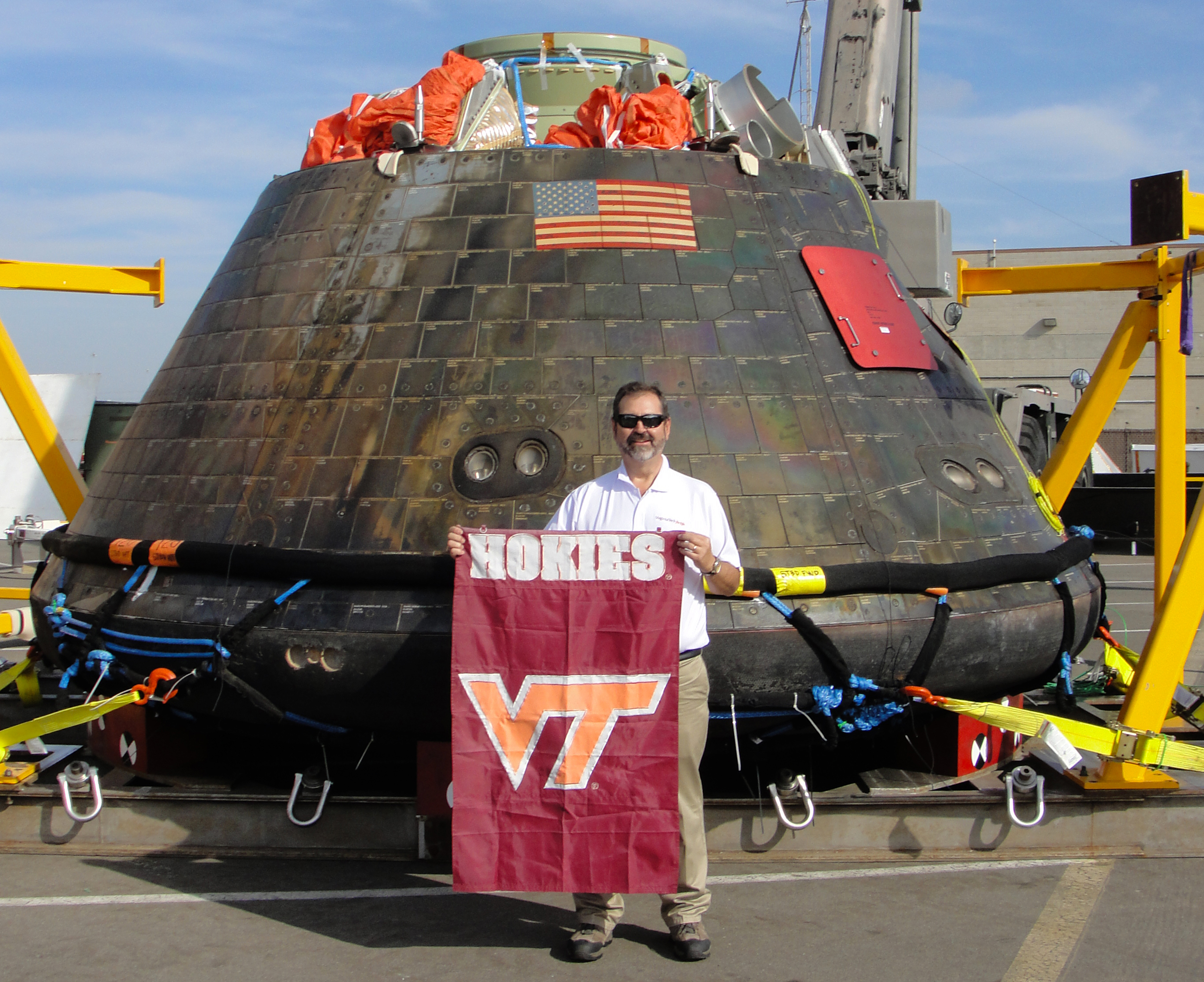Engineering alumnus Peter Reutt part of recovery team for NASA’s recent Orion spacecraft launch

Virginia Tech College of Engineering alumnus Peter Reutt was among the many engineers at NASA’s Kennedy Space Center Dec. 18 waiting for the return of the Exploration Flight Test-1 Orion spacecraft after a cross-country road trip from San Diego via tractor trailer.
Reutt also was part of the team to recover the vessel weeks before near San Diego, bringing the craft onto a ship after the capsule traveled 3,600 miles above the earth for a 5-hour unmanned mission.
“I am proud to have been part of the NASA team that recovered the Orion Crew Module,” said Reutt in a series of emails from Merritt Island, Florida, the home of Kennedy Space Center and the Dec. 5 launch of the EFT/Orion craft.
“As recovery move director in charge of access and handling of the Orion crew module, the recovery was nominal. Our prior training showed as it was a very smooth operation to bring the capsule into the well deck, offload the ship, and prepare it for return to Kennedy Space Center.”
Reutt, a 1981 graduate of the Virginia Tech Department of Aerospace and Ocean Engineering, wanted to join the space agency upon graduation. It was his dream job, a hope shared by scores of new engineers at the time. But a then-hiring freeze put off Reutt’s dream.
After working in the private sector for several years, including a stint in nuclear engineering, Reuttwas able to join the NASA team on the Space Shuttle operations contract in 1989 when the agency re-launched the program after a long pause following 1986’s Challenger explosion.
Reutt began work with Lockheed and later United Space Alliance in the payload mechanical engineering group, overseeing work on more than a 100 Space Shuttle missions that involved building the International Space Station, including support for the Russian space station Mir.
After the Shuttle program was shuttered in 2012, Reutt was hired by Jacobs Engineering Group Inc. to work on the Test and Operations Support Contract for NASA. Shortly after, he was assigned to crew module recovery operations for the new Orion mission.
The Orion craft’s nearly 5-hour, two-orbits trip is believed to have captured a great deal of information that will help NASA with its plans to carry out human-led explorations beyond low Earth orbit, out into deep space. (Mars is not out of the question, nor is a trip to float above the inhospitable Venus.)
For months, Reutt practiced recovery efforts with a team of dozens, including U.S. Navy personnel, in the waters off Virginia at first, and then near San Diego, where the craft landed via parachute. The work was challenging. Reutt was away from home for weeks on end.
Early testing revealed that even in calm seas, the water in and around the ship’s well deck that would hold the space vessel sloshed around roughly.
Reutt compared being inside the massive open well deck to standing inside a wave maker one might find at a family water park in Orlando, Florida.
Tests were done on pool volume, wave action, ship speed, and a variety of other factors. All the efforts paid off.
“We pulled the capsule into the ship,” he said.
Reutt’s work on Orion is not over. He and other member of the NASA team will create a lessons-learned report on all recovery efforts to “identify areas of improvement.” He also will return to San Diego to place the Orion recovery equipment into long term storage. NASA has been using a Navy-owned warehouse for its operations.
“Then we will revisit the current recovery method to determine if it is practical for recovering astronauts after deep space travel,” said Reutt. “There is a concern with leaving them in the capsule floating around in the ocean for too long a period of time.”
The agency also will open a new facility for processing potentially hazardous commodities on future Orion crew modules; this Payload Hazardous Support Facility is slated for first use during the next Orion mission designated as EM-1.
Reutt will be in charge of access and handling of equipment at the facility.
Reutt also will return to duties involving payloads and spacecraft operated by NASA and its partners.
“I work as a mechanical engineer and handling engineer for payloads going to the International Space Station,” he added. “There is a new system for delivering oxygen and nitrogen to the ISS now that the shuttle is retired and cannot transfer these commodities from its tanks.”
Reutt’s group loads and prepares the tanks – known as NORS – that’s short for Nitrogen Oxygen Regeneration System – for launch on the SpaceX Dragon or Orbital Cygnus. His group loads the fluid and determines the center of mass and the leak rate. His group also helps prepare other cargo, such as various science experiments and replacement components for delivery to the International Space Station.
Reutt has not forgotten his Hokie roots.
He posed for a photo with the Orion crew module after it was recovered, holding a Virginia Tech flag in the air. Additionally, he and his wife, Jane--who received her bachelor’s degree from Virginia Tech in 1982--have a son, Michael Reutt, who is a freshman at Virginia Tech and is a student-manager for the men’s basketball team.
Eric Paterson, professor and head of the Department of Aerospace and Ocean Engineering, said Reutt is one of his department’s ideal graduates.
“It’s great to see alumni out there in the field doing this kind of work. This is the ultimate blend of aero and ocean engineering.”




